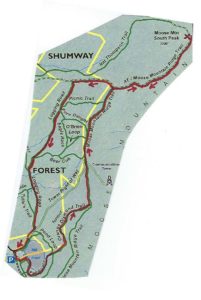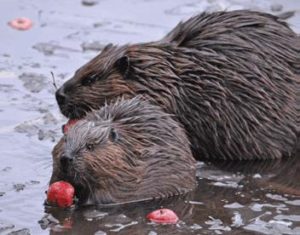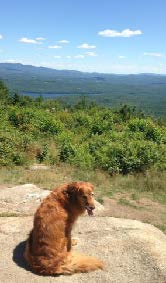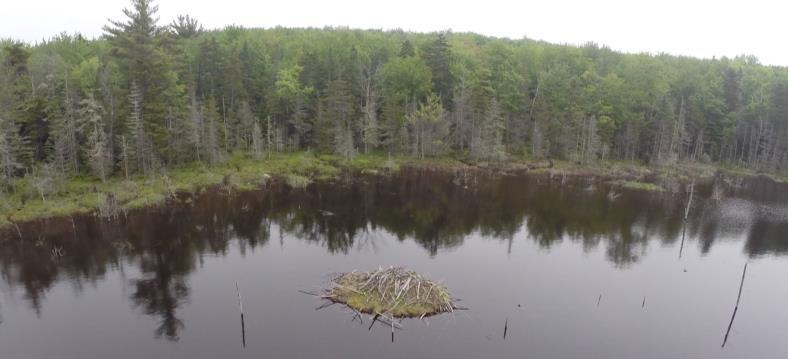Hike Information and map – full PDF
 Driving Directions
Driving Directions
- From Etna Village, head N on Hanover Center Road
- Turn R on Ruddsboro Road and drive 1.8 miles
- Turn L on Old Dana Road
- Turn R just past large red barn on R, onto Moose Mountain Lodge Road (not marked)
- Drive 0.8 miles to top of road. Park in marked trailhead parking area just past the beaver dam.
What You Should Know
- Foot travel only. Dogs are welcome but must be under close control.
- Consider bringing binoculars and a bird book for viewing waterfowl on Mill Pond.
- This hike passes through six major conservation parcels on Moose Mountain that are part of a 3,800-acre block of protected, un-fragmented wildlife habitat. The newest and largest is the 313-acre Shumway Forest, conserved by the Hanover Conservancy in June 2017.
Hiking Directions
- Begin your hike at the green Mill Pond Forest/Huggins Trail Access sign. The Huggins and Shumway families donated a conservation easement on this area in 2015 to ensure that the public would always be welcome on their trails and have a dedicated place to park.
- The trail heads E along a beaver-managed section of Mink Brook – look for evidence of beaver chews, slides, and an impressive series of dams.
- You’ll soon reach a fork; a big pine at R bears a sign for Pasture Road. Bear L on the other trail. You have arrived at the 130-acre Dana Pasture Natural Area, a wonderful piece of land that holds an important place in the Dana Family history. Today, the Town of Hanover and a Dana heir own undivided half shares.
- 15 paces from the fork, look for a cellar hole at L. This was the home of miller David Woodward, who built the dam on Mill Pond and an impressive sawmill and gristmill on the steep falls of Mink Brook below where you left your car (a visit for another day).
- Continue 75 yards to the pond’s edge and a bench that beckons you to admire the view across the 10-acre pond. This is the highest water body in the town of Hanover and the primary source of Mink Brook, the town’s largest stream. Set in a saddle on the mountain ridge, it may have originally been a small pond or perhaps a marsh. In the late 1700s, Woodward built a drylaid stone dam (just out of view at L, beyond the spruces) to raise the water level some 6-8 feet (it has since partly silted in). Then beavers took over and have been managing the pond ever since. Today, the entire shoreline remains undisturbed: Hanover Conservancy easements protect the N side with the Dana Pasture Natural Area on the S.
 Directly across from the bench is an impressive beaver lodge. Scan the pond’s surface for waterfowl and other birds. You might be welcomed by the slap of a beaver’s tail.
Directly across from the bench is an impressive beaver lodge. Scan the pond’s surface for waterfowl and other birds. You might be welcomed by the slap of a beaver’s tail.- Retrace your steps for a short distance to the Pond Loop (unmarked) at L, and begin your trip around the pond. In 3 minutes, come to a Y with the Baboon Bypass at R and an arrow pointing L.
- Turn L here, keeping the pond at L. You’ll encounter some wet places, an old corduroy (log) crossing, and lush growths of sphagnum moss, goldthread, and club moss.
- About 10 minutes’ walk from the bench, you meet a massive old white birch and side trails to the water. Continue straight to another big birch and a large maple snag, an apartment house for a variety of creatures. The trail continues around them.
- Just a few minutes later you’ll arrive at a trail junction, and you have a decision to make.
- The arrow points L to the tower road. If you just remembered you left something on the stove, this is the first of two bail-out points. To return to your car, bear L on the Pond Loop, heading N. The trail is easy to follow if you keep the pond in view at L and bear R at an arrow. You’ll leave the Dana Pasture Natural Area for the Shumway Forest before you reach the tower road 10 minutes from your decision point. Turn L to return to your car in another 4 minutes.
- If you’re game for more adventure, bear R toward the sign reading “To the O.D. Ridge Trail.” The Orange Diamond Trail was built by a local snowmobile club in the 1970s but hasn’t been used that way for years. The trail, deemed by the club as unsuitable for today’s snow machines, is now restricted to foot travel.
- Thank the Hanover Conservation Commission’s Trails Committee for restoring this and the Tom Linnell Ridge Trail, which it joins in 4/10 mile. The trail sees heavier use in winter than summer, so follow it with care.
- Continue on the Orange Diamond Trail as it heads northeast through mixed northern hardwoods for 20-25 minutes. Bear L at forks in the path. Soon you leave the Dana Pasture Natural Area, briefly visit the Shumway Forest, and enter two lots fully owned by the Town of Hanover. The Conservancy helped the Town acquire the N one in 2002. Didn’t notice a break in the forest, did you? Wildlife doesn’t either! That’s the point of keeping habitat un-fragmented here on the mountain.
- This is prime habitat for the kinds of wildlife that need large blocks of cold mountain habitat, including the snowshoe hare. We’ve seen not only the tracks but the creature itself, a white blur whizzing across a whitened winter landscape, with a bobcat in pursuit. Sheltered rocky crevices provide fine bobcat dens.
- As the Orange Diamond Trail joins the Tom Linnell Ridge Trail, bear L to head due N. The Hanover Conservancy is assisting the Upper Valley Trails Alliance and Hanover Trails Committee with their project to formalize and protect public access to the Ridge Trail for its entire route from Enfield to the South Peak, under a grant from the Quabbin to Cardigan Partnership.
- 20-25 minutes from the Pond Loop, arrive at the tower “road,” which was visible at L for the last few minutes. Here’s your second bail-out point: you can walk down the road to the gate and turn L to your car.
- The tower road was built in the 1960s for construction and maintenance of the nearby communications tower. Despite what a surprising number of maps say, it is NOT a public Class VI road that goes over the ridge to Goss Road, nor is it part of Moose Mountain Lodge Road. A private right of way, it is blocked by a locked gate just above the entry from the Lodge Road. Hanover Conservancy easements on its lower half prevent use by vehicles except for forestry, wildlife habitat management, and of course, by the tower folk.
- We hope you’re up for more adventure – if so, cross the road at its hairpin turn and re-enter the woods at the sign of the moose. The Orange Diamond / Tom Linnell Ridge Trail is wide and easy to follow here.
- In 3 minutes, the O’Brien Trail (named for the Shumways’ forester, John O’Brien) leaves at L. John has an endearing habit of arranging skid trails so they make good hiking and XC ski trails.
- Stay straight; you’ll soon encounter evidence of federal boundary blazes as the trail begins to snake the line between the Shumway Forest and federal land acquired in the 1980s for the Appalachian Trail.
- In 2 minutes, bear R at a fork and sign reading “To the A.T.” The trail becomes a narrow footpath again, easy to follow as it begins to climb along the boundary. Look for some old sugar maples whose nearness to the line may have spared them the woodman’s axe.
- Soon you’ll get hints of views to the E (R) as the trail swings L and continues up, not blazed but easy to see.
 20 minutes from the tower road, arrive at the Appalachian Trail. An orange Dartmouth Outing Club sign rests on the ground by a tree, pointing the way to the South Peak. Here, you can turn R to head to Mt. Katahdin in Maine. Turn left for Velvet Rocks, downtown Hanover, and if you’re really ambitious, Springer Mountain in Georgia. Today, we’ll turn R and take the AT for about 15 minutes to the S summit along the well-worn, gently but steadily climbing path.
20 minutes from the tower road, arrive at the Appalachian Trail. An orange Dartmouth Outing Club sign rests on the ground by a tree, pointing the way to the South Peak. Here, you can turn R to head to Mt. Katahdin in Maine. Turn left for Velvet Rocks, downtown Hanover, and if you’re really ambitious, Springer Mountain in Georgia. Today, we’ll turn R and take the AT for about 15 minutes to the S summit along the well-worn, gently but steadily climbing path.- Relish your reward at the South Peak: glorious views E, with Goose Pond at your feet and Mt. Cardigan, Sunapee, Kearsarge, and more visible on the SE horizon. At one point, the Presidentials are visible in the distance to the NE. Bedrock ledges offer comfortable seating. Search the raspberry thicket for ripe berries. You can bet the bears do.

- At this season, native steeplebush is in full bloom (L), its rosy spires of tiny flowers alive with native pollinators. Dragonflies cruise the peaceful scene today, but in 1968, Northeast Airlines flight 946 crashed near this area. The rescue effort required bulldozers to clear a path to the wreckage.
- The orange DOC sign indicates that the South Peak’s elevation is 2222’ above sea level. More refined measurements indicate it’s actually 73’ higher.
- When you’re done drinking in the view, head back down the AT the way you came. The junction for the O.D. Ridge Trail appears just after a raised log/stone section of trail. Enter the Shumway Forest once again and continue down the AT past this trail. Volunteer AT trail maintainers have been here – step over rock water bars that keep water from sluicing down the trail and creating gullies.
- About 8 minutes from the O.D. Ridge Trail junction, the trail flattens out – your cue to look for the Logging Road entering at L. Find the trail sign mounted on a large paper birch a short way in.
- Turn L here, off the AT (if you continued, you’d arrive at Three Mile Road). You’re passing through a “sandwich” of easements placed by the National Park Service in 1983. A 200’ Trail Right of Way Easement follows the AT itself with a pair of protective easements 200-461’ wide, one on each side of the Trail ROW.
- The Logging Road heads briefly uphill and then follows the contour S. You will follow it for half an hour through the Shumway Forest. This is your best chance at seeing moose that use this trail as a highway. Watch for their dinner plate-sized tracks in a few wet areas that appear here and there.
- About 9 minutes from the AT, the Picnic Trail comes in at L. Ferny openings indicate the Logging Road’s path SSW. A few minutes further at a small opening, bear L and the trail, now more clearly a former skid trail, leads on.
- Note the carefully constructed water bars on the route, built for past years’ logging operations to control water flow. Brush piles were laid to help return nutrients to the soil and provide small mammal habitat. The Shumway Forest has been under the supervision of a professional forester ever since the current owners, Kay and Peter Shumway, purchased what was then a heavily logged property in 1986 from a timber company to prevent construction of a mountaintop vacation home by another would-be buyer.
- The Shumways manage the land primarily for public recreation and also to steer the forest back to a healthy and ecologically intact system with a variety of habitats for wildlife while protecting streams and wetlands. The new conservation easement ensures that this management will continue, adding a 100’ protective buffer for those waters.
- About 20 minutes from the AT, the Bear Cub Trail comes in at L and soon you arrive at a grassy log landing. Bear L, away from the large open area, and continue up into the woods. Wildlife feed in such openings surrounded by forest cover. The Logging Road becomes stony here, hardened to take the weight of forestry vehicles. You’re starting to think this might be a wonderful ski route in winter, and you’re right!
- In 4 minutes the Middle Mountain Trail and Mountainside Trail leave at R, and in a few more, you arrive at a second log landing. Just beyond is the tower road. Signs on a tree at L include a trail map. Turn R on the tower road.
- Now it’s time to explore the north shore of Mill Pond. Two minutes from the Logging Road, the pond comes into view as you leave the Shumway Forest and enter the Mill Pond Forest, where the Shumways and Hugginses donated a conservation easement to the Hanover Conservancy in 2015.
 Turn L opposite a telephone pole and take the short trail to the water’s edge. The beaver lodge is close by, and the bench you visited earlier is visible on the far shore at 2 o’clock. Lush northern shoreline vegetation is underfoot: sphagnum moss, ferns, and lichens. This thick carpet captures sediment running off the mountainside and helps keep Mink Brook crystal clear.
Turn L opposite a telephone pole and take the short trail to the water’s edge. The beaver lodge is close by, and the bench you visited earlier is visible on the far shore at 2 o’clock. Lush northern shoreline vegetation is underfoot: sphagnum moss, ferns, and lichens. This thick carpet captures sediment running off the mountainside and helps keep Mink Brook crystal clear.- Turn R to follow the path along the shore, crossing a few beaver slides, noting the reeds with their tousled “bad hair day” seedheads. At a fork in the path, stay L on the pine-needle carpeted trail to where a small cove indicates the old dam overflow. The dam is just beyond, obscured by beaver engineering and shrubs.
- Bear R and head for the green gate at the entrance to the tower road. Turn downhill past the gate and L to return to your car.
The Hanover Conservancy holds permanent conservation easements on the Shumway Forest, Mill Pond Forest, and Huggins Trail Access, which remain privately owned. Please respect the generosity of these landowners by leaving no trace of your visit and enjoy the memories and photographs you take home.




